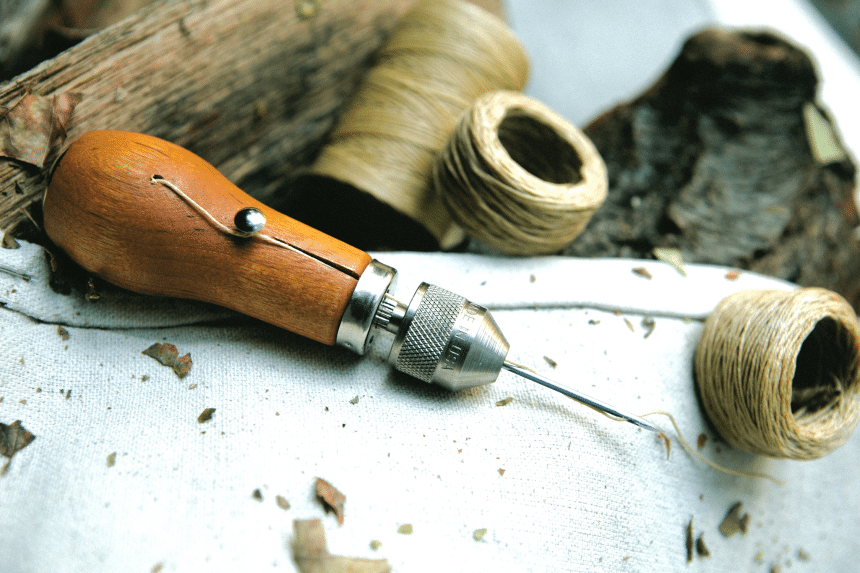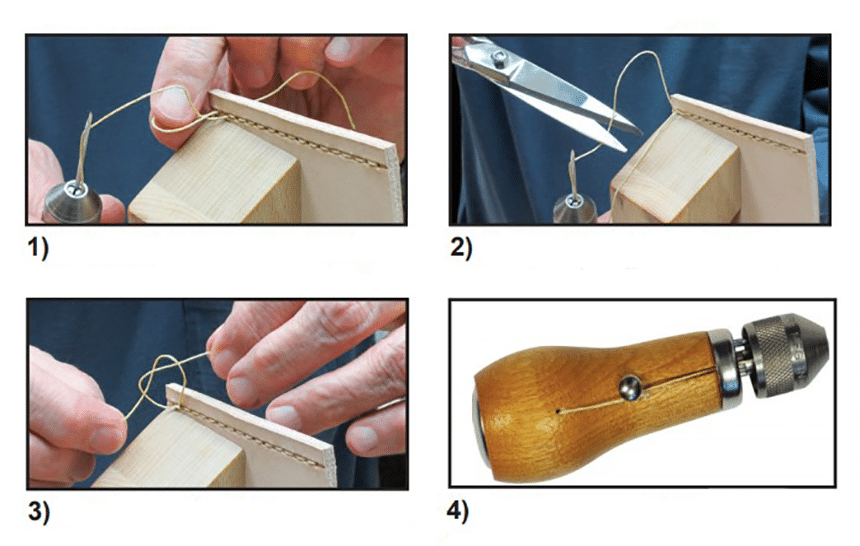

The speedy stitcher is the handiest tool any cobbler, sailor, backpacker, mountaineer, or any outdoorsy person should have in their toolbox. It creates a perfect lock-stitch by hand which is commonly used in the assembly and repair of leather goods, athletic equipment, climbing and camping gear, canvas tarps and book binding repair among others. It does come in handy for quick fixes, especially when you don’t want to get your sewing machine out for small repair tasks.
The Speedy Stitcher normally comes with the basic sewing awl, a bobbin thread and 2 different needles. These allow you to start any sewing project almost immediately. If you are a beginner, you might find it a bit challenging to set up and use the speedy stitcher and that’s what we are here for. Read on for more hints and hacks on how to use a speedy stitcher.
 The Speedy Stitcher sewing awl is a tool that can be used around the house, farm, workshop or any place with leather, vinyl or canvas that needs to be sewn. The helpful hand tool can basically sew any heavy material.
The Speedy Stitcher sewing awl is a tool that can be used around the house, farm, workshop or any place with leather, vinyl or canvas that needs to be sewn. The helpful hand tool can basically sew any heavy material.
All Speedy Stitcher are
made in the USA
Trusted Source
Speedy Stitcher Sewing Awl
The Speedy Stitcher, made in America, can be used to hand sew any heavy
material such as leather or canvas. A handy tool to have around the house,
farm, or any place where heavy material has to be sewn.
www.speedystitcher.com
and they feature a high-tensile waxed thread and diamond-point needles that are custom made. The tool is used to sew a perfect
lock stitch
Trusted Source
Lockstitch - an overview | ScienceDirect Topics
Lockstitch should be used for attaching sew-on hooks and bars, and not chainstitch button-sew, as it is more reliable and consistent.
www.sciencedirect.com
just like a sewing machine in situations where it’s impossible to use one. You may have the best heavy-duty sewing machine for heavy materials out there, but can you carry it to your camping trip? Or the best sewing machine for leather but you can’t bring it with you to fix your hiking boots when you go rock climbing.
It is mostly used to assemble and repair canvas tarps, climbing, camping and sailing equipment, leather goods, book binding repair, saddlery items, shoes and belts. Anyone can have a Speedy Stitcher in their toolbox, from a cobbler to a sailor or climber.
In some cases the Speedy Stitcher sewing awl comes pre-threaded. The bobbin in the base of the awl usually has waxed polyester thread and you get an extra 30 yards in the package. The thread the awl comes with is of standard weight. If you wish to use a heavier or lighter thread, you can buy separately.
You should use fine thread for projects that have thinner material like tent canopy fabric or any breathable tent fabric and thinner shoe fabric. Also, the fine thread will work best with the small straight needle in the number 130.
According to most reviews the Fine Polyester Thread 180 yd is one of the best fine threads that money can buy. The thread is popular because it fits all speedy stitcher sewing awls and needles and is made with the highest quality materials. What’s more, it can be used both for indoor and outdoor purposes.
For a shorter alternative, you can go with the equally popular Speedy Stitcher Polyester Thread. The thread is fine and 30yd long. It is the one usually included in the Speedy Stitcher package and so its quality is out of the question. Whether it’s your camping tent or single pair of socks that is ripped off, this thread will come in handy when you need to do repairs both for indoor and outdoor purposes.
For heavy fabrics like leather, boat sails, heavy-duty canvas baseball gloves and other sports equipment, use coarse thread. It works well with the large straight needle or the large curved needle if it is too coarse.
The good thing about getting a different type of thread from the one provided with the package is that you don’t have to unwind the entire bobbin. You just need to create enough space on the bobbin then wind in the new sewing thread, just enough to finish your project.
Here is a step by step guide on how to thread a Speedy Stitcher, just in case you need to use a different thread from the one the awl comes with:
 1. Pull out the end cap at the bottom of the awl’s handle to access the bobbin. It’s not going to be so easy if you have long fingernails.
1. Pull out the end cap at the bottom of the awl’s handle to access the bobbin. It’s not going to be so easy if you have long fingernails.
2. Pull the end of the thread gently to unwind just enough for finishing your project and about 3 inches extra. Insert the end of the thread through the slot at the handle’s top then through the hole on top of the ferrule. Now, this hole is usually in a bit of an odd angle making it somehow difficult to pass the thread. You can insert the thread end through a regular hand sewing needle then pass it through the hole for an easier time.
3. Wrap the thread around the tack on top of the handle to create tension during sewing.
4. Choose one of the needles the insert it into the threaded post. Push it to the very end then thread it. On top of the handle, is a groove that acts as a thread guide? Also, ensure that the needle aligns with the groove on post.
5. Replace the chuck lock by screwing it back into place then pull out the thread to the length needed to complete the project.
 Before you start stitching, prepare your project for stitching for an easier time and better results. If you are working on a leather project, use a stitching groover to mark the stitching path. This will help you to maintain straight stitches. You can also use a stylus to make a clear guideline. You can also invest in a 3-hole punch for pre-punching holes in the leather for easier stitching.
Before you start stitching, prepare your project for stitching for an easier time and better results. If you are working on a leather project, use a stitching groover to mark the stitching path. This will help you to maintain straight stitches. You can also use a stylus to make a clear guideline. You can also invest in a 3-hole punch for pre-punching holes in the leather for easier stitching.
If your project is canvas or upholstery, use chalk or a pencil to draw a clear guideline. Other tools that can make stitching a breeze for you are the overstitch wheel and the stitching pony. The overstitch wheel is for marking the hole placement and the stitching pony is for holding your project steady during stitching.
Here is how to make basic stitches with a Speedy Stitcher sewing awl kit:
1. Push the needle through the material of your project from the back side. When on the front side, pull out thread, long enough to do stitching plus an extra 3 inches.
2. Hold the awl’s handle with your thumb over it then hold the thread with your other hand and pull the needle back out of the hole to start it through the second hole.
3. Push the needle through the second hole to a far extent then pull the awl back just a little to form a loop.
4. Pass the entire thread through this loop.
5. Hold the thread’s end tight then pull the needle out of the hole to form a lock-stitch. Pull tight until you see the lock-stitch knot disappear in the middle of the fabric layers.
6. For the next stitch, release more thread between the material and the needle. Repeat the procedure until you reach the end.
 If you don’t finish the stitching correctly, the stitches may unravel sooner than you expect. Here is how to go about it:
If you don’t finish the stitching correctly, the stitches may unravel sooner than you expect. Here is how to go about it:
1. After you have pushed the needle through the last hole on the back side of your project, grasp a loop and pull the needle out of the hole.
2. Cut the thread and leave about 6 inches to tie.
3. Tie the ends of the thread in a taut knot on the backside of the project then trim the remaining ends. That’s it! You have successfully used a speedy stitcher sewing awl to make a basic lock-stitch.
4. Once you are done working on your project, you need to store the speedy stitcher safely to increase its longevity and safety purposes. Remove the needle from the threaded post and return it to its original spot. Replace the chuck lock then keep the awl in a tool box.
Once you learn how to use a Speedy Stitcher sewing awl, you will never worry about making small repairs to your sports equipment, leather items or camping and backpacking items when you are on the go. We have provided enough sewing awl techniques in the guide that any beginner can benefit from. It is not rocket science and if you know how to sew canvas using a lock-stitch then you will breeze through the process of sewing any heavy material. You will be able to produce perfect lock-stitches like a sewing machine.
Speedy Stitcher kits come ready to use with needles and a waxed polyester thread. The best thing about it, is that its bobbin can be wound with any thread of your choice.